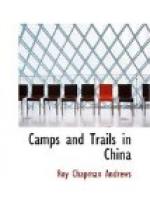In the afternoon of January 21, we rode down the mountain to the great Yung-chang plain, and for two hours trotted over a hard dirt road. The plain is eighteen miles long by six miles wide and except for its scattered villages, is almost entirely devoted to paddy fields. The city itself includes about five thousand houses. It is exceedingly picturesque and is remarkable for its long, straight, and fairly clean streets which contrast strongly with those of the usual Chinese town. At the west, but still within the city walls, is a picturesque wooded hill occupied almost exclusively by temples.
We ourselves camped between two ponds in the courtyard of a large and exceptionally clean temple just outside the south gate of the city. It was the Chinese New Year and Wu told us that for several days at least it would be impossible to obtain another caravan or expect the natives to do any work whatever. It was a very pleasant place in which to stay although we chafed at the enforced delay, but we made good use of our time in photographing and developing motion picture film, collecting birds and making various excursions.
Chinese New Year is always interesting to a foreigner and at Yung-chang we saw many of the customs attending its celebration. It is a time of feasting and merry making and no native, if he can possibly avoid it, will work on that day. Chinese families almost always live under one roof but should any male member be absent at this season the circumstances must be exceptional to prevent him from returning to his home.
It is customary, too, for brides to revisit their mother’s house at New Year’s. On our way to Yung-chang and for several days after leaving the city, we were continually passing young women mounted on mules or horses and accompanied by servants returning to their homes. New clothes are a leading feature of this season and the dresses of the brides and young matrons were usually of the most unexpected hues for, according to our conception of color, the Chinese can scarcely be counted conspicuous for their good taste. Purple and blue, orange and red, pink and lavender clash distressingly, but are worn with inordinate pride.
These visits are not an unalloyed pleasure to the bride’s family. Dr. Smith says in “Chinese Characteristics”:
When she goes to her mother’s home, she goes on a strictly business basis. She takes with her it may be a quantity of sewing for her husband’s family, which the wife’s family must help her get through with. She is accompanied on each of these visits by as many of her children as possible, both to have her take care of them and to have them out of the way when she is not at hand to look after them, and most especially to have them fed at the expense of the family of the maternal grandmother for as long a time as possible. In regions where visits of this sort are frequent, and where there are many daughters in a family, their constant raids on the old home




